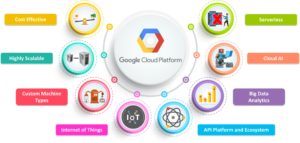“Recovery from COVID will serve as a catalyst for transformation in the fast forward”
There are moments in our history when everything changes. How we live, how we work, how we communicate, how we learn, all seem to transform in what seems like an instant, making what came before feel distant and of another era.
As Google Cloud partner, we saw the incredible changes that were happening with COVID, especially for how people worked in offices, but also how software developers and IT practitioners innovated.
These changes acknowledged that our economic recovery will look different than its past. And through these changes, boards and executives recognized that recovery, as it has been throughout history, will be a catalyst for transformation in fast forward.
Setting up Transformation Cloud
There have really been two stages to the cloud that have mostly played out:
First, was the Cloud Virtual Machine, the VM Cloud era. New companies, mostly startups, realized that they could forego ever buying or operating hardware and start in the cloud. This was a key catalyst for many of the great native cloud companies we all rely on today. By the end of this first VM Cloud Era, it became very rare for startups to operate their own data centers.
Second, and what’s really been building for the last decade, was the Infrastructure Cloud era. It’s been defined by organizations migrating their IT infrastructure to the cloud. Take your servers, and move it to the cloud. Shift your existing data storage and data estate to the cloud, but it’s still pretty much the same thing. Take your old-school email, calendar, and file sharing, and have it run in the cloud. This has been REALLY important, as it has enabled cost savings as things can scale up and down, faster development without having to do long-term infrastructure planning, improved security, and the ability to redirect more people and other resources to building new capabilities versus simply managing infrastructure. And we saw how, in this last decade of the Infrastructure Cloud, companies splintered into two groups: those that migrated much of their infrastructure to the cloud and continued to exist, while companies that ignored this migration were generally left behind.
That said, while the ROI(Return On Investment) of these early cloud migrations was important, it didn’t deliver on compelling transformative or disruptive results as many had hoped, and it hasn’t fundamentally changed how business leaders and employees work outside of IT. It was taking old-school IT and changing the operating model only. This is because simply migrating and ‘lifting-and-shifting’ systems alone do not catalyze a digital transformation, and ultimately digital transformations are not simply about leveraging cloud infrastructure.
How could Google Cloud be most helpful for businesses? It was clear that more infrastructure wasn’t enough. When change moves fast-forward, companies need someone to solve with them, a strategic partner on high-velocity innovation for their customers and their employees.
The really interesting conversations are how we get to a third phase, the Transformation Cloud, where we’re not just making an infrastructure decision, but truly embedding the need and capability to transform throughout the company. Digitization is now fundamental and this phase moves from what might have been a top-down corporate strategy and an initiative for infrastructure, to fully infusing transformation, letting every person and team in your organization transform.
Shared Best of Breed Capabilities
Finally, companies’ Transformation Clouds are going to be built on top of Infrastructure clouds and want to make sure they can use the same operating models and underlying tools across all of them with the strongest foundation. Google has significant strengths here:
First, Google Cloud is easy-to-use and self-optimizing. Developers, from students to corporate, tell us Google Cloud has a clean, modern experience designed for easily deploying cloud services at hyper scale. From its origin, our cloud platform was designed by developers for developers. Whether it stems from developer exuberance over Cloud Run, Firebase, or BigQuery, we will continue our focus on ensuring Google Cloud is helpful to developers from their initial interaction as a youth developer through their seasoned experiences throughout their professional progression.
Second, Google Cloud delivers the best Cloud value. Operating as efficiently and as predictably as possible is critical. Google Cloud increases operational efficiency and optimizes IT spend. It saves money with its transparent and innovative approach to pricing and reduces time spent on platform management. Additionally, project-level billing provides visibility into the ROI of specific initiatives.
Third, Google Cloud is the cleanest cloud in the industry. Google creates tools and invests in technology that will foster a carbon-free future for everyone and enable companies to reduce their carbon footprints. Google Cloud is the only major cloud provider to purchase enough renewable energy to cover our entire operations, enabling us to operate the cleanest cloud in the industry. When running on Google Cloud, our customers’ usage is carbon neutral, and the electricity used to power workloads is matched 100% with renewable energy.
Why Google Cloud Platform(GCP)?
- Pricing: GCP leaves all the competition way behind with its highly flexible pricing and is rightly a leader here
- Scalability: Scaling down can always be an issue with cloud services. GCP lets you scale up and down with extreme ease
- Custom Machines: With Custom Machine Types you can easily create a machine type customized to your needs with discount implications up to 50% off
- Integrations: Easily use various API’s, practice Internet of Things and Cloud Artificial Intelligence
- Big Data Analytics: Use Big Query and Big Data Analytics to carry out plethora of analytical practices
- Serverless: Serverless is a new paradigm of computing that abstracts away the complexity associated with managing servers for mobile and API back-ends, ETL, data processing jobs, databases, and more.
We are already seeing tremendous success with leading companies embracing the Transformation Cloud, moving their businesses well beyond infrastructure and migrating, in fast forward, towards the next era of their cloud evolution. This is an era where no company is better positioned to lead, in the Data Cloud, the Open Cloud and the People Cloud, than Google.








